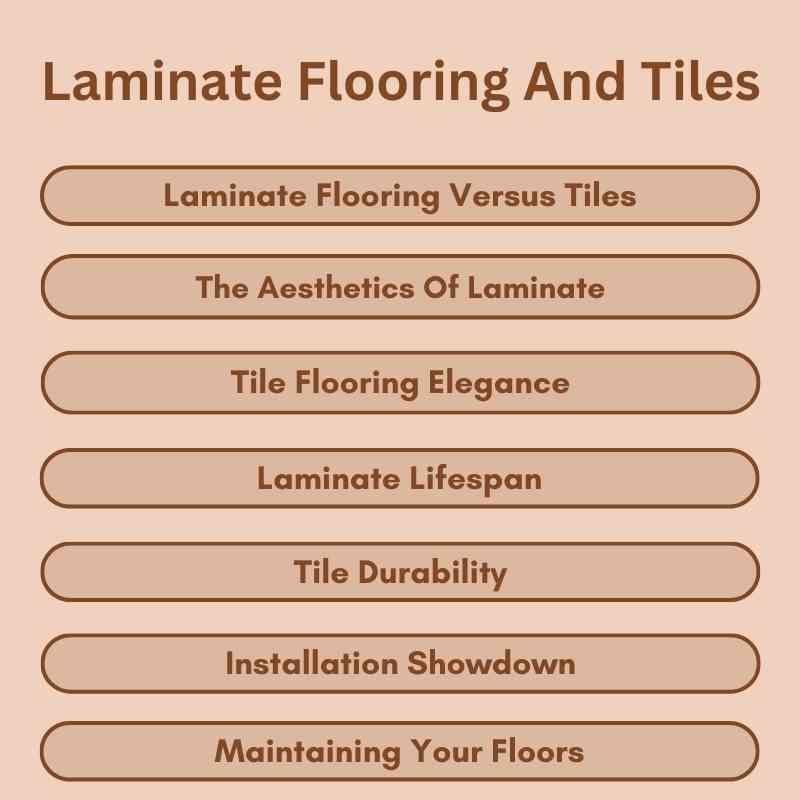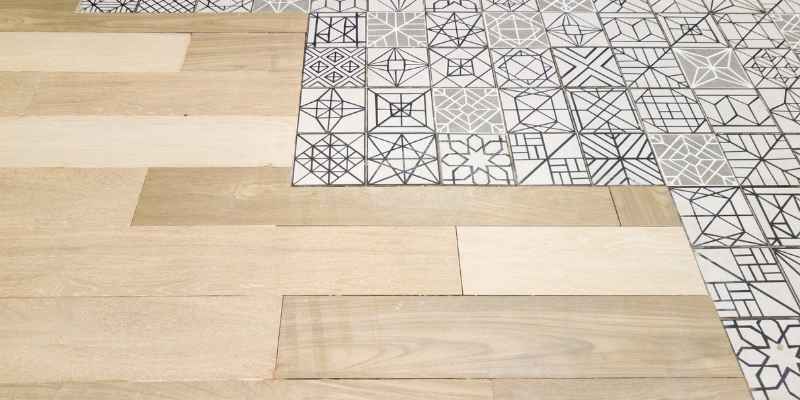Laminate flooring mimics wood or stone, offering durability at a lower cost. Tiles provide a versatile, water-resistant option for various spaces.
Choosing between laminate flooring and tiles can significantly impact your home’s aesthetic and functionality. Both options cater to different needs and preferences. Laminate flooring is ideal for those seeking a budget-friendly, easy-to-install solution that resembles natural materials. It works well in living areas and bedrooms.
On the other hand, tiles are perfect for wet areas like kitchens and bathrooms, thanks to their water-resistant properties. They come in various styles, colors, and textures, allowing for personalized design choices. Understanding the strengths and weaknesses of each will help you make an informed decision that suits your lifestyle and decor.
Laminate Flooring Versus Tiles
Laminate flooring is generally more durable than tiles. It resists scratches well. Tiles can crack easily under heavy impact.
Installation of laminate flooring is simple and quick. Most homeowners can do it themselves. Tiles require professional installation and more time.
Cost is a major factor. Laminate flooring is usually cheaper than tiles. Tiles can add value but cost more upfront.

The Aesthetics Of Laminate
Laminate flooring offers a wide variety of styles. You can find options that mimic wood, stone, or ceramic tiles. This makes it easy to match any home decor.
Texture and color play a big role in the choice of laminate. Smooth, textured, or glossy finishes are available. Colors range from light shades to dark hues. This variety lets you create the perfect ambiance.
Creating visual appeal is simple with laminate flooring. It can make rooms look larger or cozier. With the right choice, spaces feel more inviting and stylish. Laminate is not just practical; it adds beauty to your home.
Tile Flooring Elegance
Tile flooring offers timeless beauty that enhances any space. Many homeowners choose tiles for their elegance and durability. The wide range of materials includes ceramic, porcelain, and natural stone. Each material adds its unique charm to a room.
Patterns and designs vary greatly. From classic to modern, there’s something for everyone. Geometric patterns can make a bold statement. Subtle textures offer a more understated look.
| Material | Benefits |
|---|---|
| Ceramic | Affordable and easy to clean. |
| Porcelain | Highly durable and water-resistant. |
| Natural Stone | Unique appearance and long-lasting. |
Laminate Lifespan
Laminate flooring can last a long time with proper care. Regular cleaning helps prevent dirt build-up. Use a soft broom or vacuum to keep it clean.
Choose the right cleaning products. Avoid harsh chemicals that can damage the surface. A damp mop works well for deeper cleaning.
Wear and tear resistance is a key benefit of laminate. High-quality laminate can withstand scratches and dents. Use area rugs in high-traffic zones to protect the flooring.
Longevity factors include humidity and temperature. Keep the room well-ventilated and at a stable temperature. Avoid exposure to direct sunlight for long periods.
Tile Durability
Tile durability is crucial for homes and businesses. Tiles can easily withstand high traffic. They resist wear and tear from constant foot traffic.
Tiles are also resistant to elements. Water, sunlight, and temperature changes do not affect them much. This makes tiles ideal for kitchens and bathrooms.
Long-term performance of tiles is impressive. They can last for many years with proper care. Regular cleaning helps maintain their beauty and strength.
Installation Showdown
Laminate flooring is often chosen for its DIY friendliness. Many homeowners can easily install it themselves. This type of flooring usually comes in planks that snap together. The process requires minimal tools, making it a popular choice.
On the other hand, tiles often need professional installation. The installation involves precise measurements and cutting. Professionals ensure a flawless finish and help prevent future issues.
The time and tools required differ significantly. Laminate flooring can take a few hours for a small room. Tile installation can take days, depending on the complexity. Tools for tiles include trowels and spacers, while laminate only needs basic tools.
Maintaining Your Floors
Regular cleaning helps keep your laminate flooring and tiles in great shape. Use a soft broom or vacuum to remove dirt and debris. For deeper cleaning, a damp mop with a gentle cleaner works well. Avoid using too much water to prevent damage.
Inspect floors often for any signs of damage. Scratches or chips can happen over time. Use a repair kit to fix small issues. For larger problems, consider hiring a professional.
Taking preventative measures can save time and money. Place mats at entrances to trap dirt. Avoid wearing shoes indoors to reduce wear. Use furniture pads to protect floors from scratches.
Economic Aspects
Laminate flooring usually has a lower initial investment than tiles. It is a great choice for budget-conscious homeowners. Tiles can be more expensive due to their material and installation costs.
Over time, laminate flooring can offer good value. It resists wear and tear better than some other options. Tiles, while durable, may not always be the best choice for every area.
| Type | Repair Costs | Replacement Costs |
|---|---|---|
| Laminate | Low | Moderate |
| Tiles | Moderate | High |
Repairing laminate flooring is easier and cheaper than tiles. Tile repairs often require professional help. Replacement costs for tiles can be significant, while laminate is more manageable.
Environmental Considerations
Sustainability of materials is key in choosing laminate flooring and tiles. Many products come from renewable sources. This reduces the impact on forests and ecosystems.
Eco-friendly production processes use less energy and water. Manufacturers are adopting green practices. This helps in reducing carbon footprints during production.
Recycling possibilities for laminate and tiles are increasing. Many materials can be repurposed or reused. This leads to less waste in landfills and promotes a circular economy.
Comfort And Health Implications
Underfoot comfort is important for any flooring choice. Laminate flooring feels softer than tiles. It provides a warmer surface, reducing stress on joints. This is especially helpful for children and older adults.
Allergen accumulation can be a concern with different flooring types. Tiles can trap dust and allergens in grout lines. In contrast, laminate surfaces can be easier to clean. Regular cleaning helps reduce allergy triggers.
Indoor air quality matters for a healthy home. Laminate flooring often uses fewer harmful chemicals. This means lower VOC emissions compared to some tiles. Better air quality leads to a healthier living space.
The Verdict
Laminate flooring and tiles both offer unique benefits. Choosing between them depends on your lifestyle and preferences.
For active families, laminate flooring is durable and easy to clean. It can withstand heavy foot traffic. On the other hand, tiles are great for kitchens and bathrooms. They resist water and stains very well.
Think about your aesthetic preferences. Laminate comes in various designs that mimic wood and stone. Tiles offer endless colors and patterns to match any decor.
Final recommendations depend on your needs. Choose laminate for warmth and comfort. Go for tiles if you need durability in wet areas. Both options enhance the beauty of your home.

Frequently Asked Questions
What Are The Benefits Of Laminate Flooring?
Laminate flooring offers durability and affordability. It’s resistant to scratches and easy to clean, making it ideal for busy households. Additionally, it mimics the appearance of natural wood or stone, providing aesthetic appeal without the high cost. Installation is straightforward, allowing for quick home upgrades.
How Do Laminate Flooring And Tiles Compare?
Laminate flooring and tiles have distinct features. Laminate is softer underfoot and warmer, while tiles are harder and cooler. Tiles are more moisture-resistant, making them suitable for bathrooms. However, laminate is often less expensive and easier to install. Choose based on your space requirements and personal preferences.
Can Laminate Flooring Be Installed In Wet Areas?
It’s generally not recommended to install laminate flooring in wet areas. Excess moisture can cause warping and damage over time. However, some laminate products are specifically designed to withstand humidity. For areas like bathrooms, consider using water-resistant options or traditional tiles instead for better durability.
How To Clean Laminate Flooring Effectively?
To clean laminate flooring, use a damp mop and a gentle cleaner. Avoid excessive water, as it can seep into seams. Regular sweeping or vacuuming helps remove dirt and debris. For tough stains, a mixture of vinegar and water can be effective.
Always follow manufacturer recommendations for maintenance.
Conclusion
Choosing between laminate flooring and tiles depends on your specific needs. Each option offers unique benefits, from durability to style. Consider your budget, maintenance preferences, and overall design goals. With careful selection, both can enhance your space beautifully. Make an informed choice to enjoy lasting satisfaction in your home.

